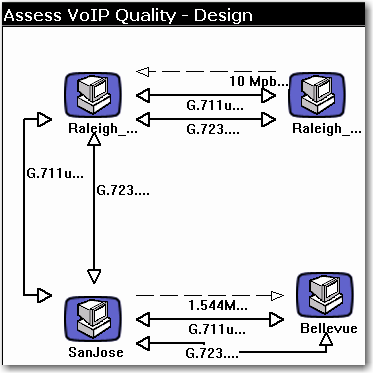12.5 Sample VoIP Quality Assessment
The Sample assessment was designed to illustrate good VoIP Quality assessment design principles. In addition, the assessment has already been scheduled, verified, and activated. For the purposes of the Sample assessment, we will review only the design. However, for an actual VoIP Quality assessment, you must perform all relevant steps. For more information, see Section 7.0, Task 5: Assessing VoIP Quality.
In the Sample assessment, expand the Assess VoIP Quality tab and click the Design view tab.
The Sample assessment deploys endpoints in a variety of locations and creates call groups to assess local and long-distance calling on a corporate network, using two different codecs.

As you can see from the Design view, two call groups contain endpoints located in Raleigh. Two VoIP connectors run simulated calls between these endpoints using different codecs, G.711u and G.723.1, so that the performance of each codec can be compared.
Two other call groups using the same two codecs send VoIP traffic across a WAN link between Raleigh and San Jose. A WAN link in your network is likely to cause VoIP performance issues and should be a part of any assessment.
The final two call groups run calls between San Jose and Bellevue over a long-distance link that is not a geographically dispersed as the Raleigh-San Jose link. The same two codecs are compared.
Take a look at Section 12.6, Sample Reports to see how this design helps identify which codecs perform the best. You can also compare MOS impairments that were caused by external factors, such as a slow WAN link, with impairments that were caused solely by the codec. In VoIP Quality Assessment Results, notice how we isolated a slow network segment by comparing the performance of the worst-performing call group using the G.711u codec with that of the worst-performing group using the G.723.1-ACELP codec.